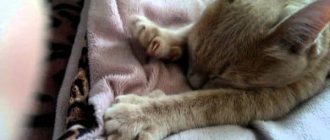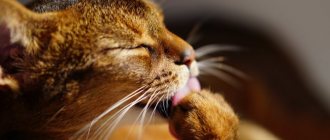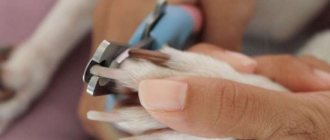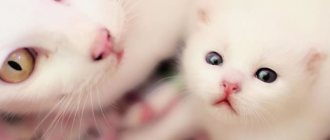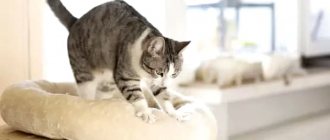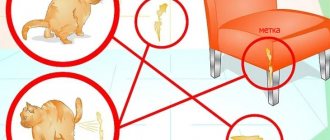Having a little furry friend makes the house more fun. But sometimes a beloved cat can restore order in the apartment. In the article, we told you why your pet needs to sharpen its claws, how to choose a scratching post and where to place it. After reading, you will learn how to teach your cat to sharpen its claws on a scratching post. You will also understand how to protect valuables from pet scratches.
Why do cats sharpen their claws?
Often, owners who notice their pet friend sharpening his claws think that the animal is playing. In fact, sharpening their claws is a common desire of cats. They need this to get rid of exfoliated and very long claws. This is how four-legged animals keep their bodies in excellent physical shape and take care of their health.
If your pet is deprived of the opportunity to sharpen its claws, it will try to bite them off. Such actions of the cat will lead to breaking of the claws.
Instinctively, cats sharpen their claws to mark their territory. Through the pet's paw pads, the glands secrete a special secretion that can be detected by the animal's sense of smell. By leaving his tracks, the tailed animal shows that the place is occupied, he is the owner. In addition, after sleep, the cat needs exercise - it clings to something with its claws and warms up.
Cats like to mark their territory
Sometimes the animal sharpens its claws to attract the owner's attention. To prevent the cat from scratching the furniture and ruining anything, it is necessary to train it to do this in a certain place. For this purpose, a scratching post is used, which saves things in the apartment in such cases.
https://youtu.be/PRgcpu92g8c
Why does a cat need a scratching post, or Why do cats scratch furniture?
The cat is a predatory animal that hunts in the wild. Teeth and claws are its main weapons. The need to sharpen them is inherent in her at the level of instinct - hunting with long or blunt claws is ineffective, and it will be more difficult to stand up for yourself when attacked by an enemy. Domestic cats are unable to wear down their claws by climbing trees and running over rocks, so they find other ways to solve the problem, such as scratching furniture.
The need to remove the overgrown stratum corneum is not the only reason for a cat to damage household property. The cat is a territorial animal. On the pads of her paws there are sweat glands that secrete a special secretion. When she releases her claws and scratches, its production increases. Humans cannot smell this secretion, but other cats can smell it without difficulty. Such a mark indicates the assignment of territory to a specific individual.
Other reasons that a cat “unfolds its claws”:
- The pet expresses its benevolent attitude.
- A cat is motivated to scratch furniture by the need to relieve nervous tension. This process helps to cope with psychological discomfort and throw out aggression.
- The animal does a kind of gymnastics, stretching and stretching its muscles.
It is not harm that causes a cat to scratch furniture, but a natural instinct. A scratching post is needed so that the cat can use it in full and not to the detriment of property. Without this device, the animal will sharpen its claws wherever it sees fit. At the same time, there is a risk that the stratum corneum will not be removed sufficiently, which will lead to breaking off and ingrown claws.
Types of scratching posts
There are many varieties of accessories for sharpening claws.
Basic materials of scratching posts:
- jute;
- cardboard;
- tree;
- sisal.
Jute sharpener models are more durable than cardboard ones. Cats' claws easily catch on cat accessories. A jute scratching post can be used for several years. A cardboard sharpener is suitable for kittens.
Despite the fact that they are inexpensive, these sharpeners quickly become unusable. Adult animals can ruin them in a few weeks. Sisal scratching posts have a rough feel to the touch. At the same time, they are stronger than jute ones. Sisal is similar to tree bark and is interesting to animals. The wooden sharpener is durable. But if it is of poor quality, your furry friend may get hurt.
Types of scratching posts:
- horizontal panel;
- vertical panel;
- column;
- house;
- complex.
The simplest and most common sharpeners are vertical and horizontal panels. A vertical scratching post is suitable for those who like to sharpen their claws on walls and doors. Horizontal models are suitable for animals that prefer to sharpen their claws on the floor. The cat can rest on this type of sharpener.
For those who like to scratch the door frame - a vertical scratching post
The column is one of the popular models. It is a pillar that is wrapped in a tourniquet. The model is used as a scratching post and exercise machine. During sharpening, the cat stretches to its full height and stretches its back muscles. This type of exercise is beneficial for pets who sleep a lot. With such a sharpener, it is easier to keep the apartment clean: fallen claws are not scattered throughout the rooms, but lie in one place.
The houses are used by animals not only as a scratching post, but also as a place to sleep. In addition to a special wall or column, the model has a house in which the pet can hide and sleep.
The complex is the most expensive and multifunctional model. It contains: a place to rest, passages, stairs, a sharpener. The complex has everything a pet needs: a place to sleep and play. The cat can spend time in his complex all day.
In the house, your pet will hide from the hustle and bustle and get plenty of sleep
What should you pay attention to when choosing a scratching post?
When choosing a scratching post, you need to consider several factors. Firstly, it must be durable. If the product is vertical, it should be tall. The cat will ignore the short sharpener.
Secondly, the sharpener should not swing or move. The stability of the product is ensured by a wide, heavy base. If the scratching post moves, the cat may get scared. In addition, such a sharpener may fall on the cat and he will no longer dare to approach it.
Your cat should like the texture of the sharpener. You should not buy an item with plastic elements or artificial winding. These materials are static and can shock your pet.
Each tailed animal should have its own sharpener. If there is only one, pets may mark it over and over again to remove the foreign scent. Because of this, it will spoil in a few weeks.
Every furry friend should have their own favorite scratching post.
A little about declawing
Many clinics offer declawing surgery. Perhaps many consider this a reasonable compromise in the cohabitation of a person and a cat. But think critically: it’s just your whim - so that the sofa remains intact, so that neither you nor the child gets scratched, so that there are no puffs on the curtains. Comfortable. Mostly, you get a kitten for yourself - in order to experience positive emotions every day, and not for its own good (this is not the primary point - so as not to freeze, die, etc., if the kitten is from the street), and it should not pay for it!
Remember that declawing is a surgery. Firstly, cats have a very difficult time recovering from anesthesia. This is a painful condition for them. Secondly, she will try to stand on her paws already on the 5th day! It will be painful for her to get up to eat or walk to the litter box. Thirdly, healing is always very long, complications often arise, and wounds fester. It's all pain! The cat’s claws are not only removed, but the first phalanges are cut off. This leads to disruption of the vestibular apparatus and nerve endings. The animal becomes disabled. Is it worth doing this to ensure that your sofa remains intact?
For information: declawing surgery is prohibited in the European Union and is a criminal offense.
Where to place the scratching post?
We recommend placing the accessory in places where your pet usually likes to sharpen its claws. If your pet friend sharpens his claws on a chair or door, then place a post nearby. If the animal prefers to sharpen its claws on the carpet, place the product horizontally. As soon as the four-legged animal understands why the sharpener is needed and begins to use it, the scratching post can be moved to a place convenient for you.
Horizontal models are best left near the place where the cat sleeps, eats or plays. After sleep, animals like to stretch their legs and sharpen their claws. If the product is located next to the tailed one, it will not scratch the furniture on its way to the sharpener. This way he will fully wake up and quickly mark his territory. After the tailed cat eats, he most often wants to play and run. A sharpener with a toy located near the kitchen will help the cat burn off energy and have fun.
Look at the place where the cat usually sharpens its claws
How to find out if your cat loves you?
Nine Signs Your Cat Really Loves You
- The cat
treats you like a relative. ... - She rubs against you
. ... - The cat
follows on your heels. ... - Murka loves
to lie next to you when you sleep. ... - They blink their eyes slowly. ...
- The cat
crumples its paws about
you
. ... - Your cat
is purring. ... - She shows you her belly.
Training rules
A scratching post is a useful accessory that can protect furniture from cat claws. But in order for the animal to start using it, it is necessary to do a little work to accustom the pet to the product. There are several methods you can use to help your cat get used to the sharpener.
We use games
Your pet may get used to the sharpener during playtime. For this purpose, toys with tails are used. The tail can be drawn near the object, along the claw itself. Having become carried away, the animal begins to play with the product. Using this method, the four-legged animal quickly remembers where to sharpen its claws. In addition, you can attach a toy to a board or post for the cat. Then your pet friend will play near the scratching post himself at any time.
Your pet will quickly get used to the sharpener while playing.
Affection and delicacy
Any animal loves to be praised. When your furry friend uses the nail clipper for its intended purpose, you should give him a treat or pet him. The pet will understand that he is being rewarded for certain actions. After this, he will be more willing to approach the accessory.
Should I use mint or valerian?
Valerian preparations attract cats with their aroma. Dry valerian and catnip can be used in moderation when training to sharpen. The upper part of the product can be slightly scented and cats and cats will climb to the source of the smell. The pet will often turn its attention to the accessory and get used to the claw clipper.
It is worth considering that frequent use of these products is not recommended, as they have an intoxicating effect. Males react especially restlessly to valerian, since the plants contain essential oils that resemble the smell of sex hormones. Consuming a small amount of the substance will not harm your pets. At the same time, mint has a calming effect on the animal.
Using smells
There are scents that, on the contrary, attract cats.
This is the well-known valerian and catnip. These herbs can be purchased at a pharmacy or pet store https://zoozavr.detmir.ru/. A decoction of these herbs should be sprinkled on the nail polisher. An unusual and attractive smell for cats will attract your pet. Therefore, he will often visit this place. But if you put the owner’s things here, the cat will also visit this place, this smell will be attractive to the pet. For pets living in a large house, it is recommended to use several scratching posts. Usually they are placed in different places. One of them should be in your favorite one.
To train an adult cat it will take about a month, sometimes a little longer in some cases. You can't get upset and give up. The owner's patience and calmness will help the cat learn the new accessory and its purpose.
How to train adult cats to use a scratching post
It's never too late to accustom your tailed dog to a scratching post.
Teaching a grown pet to use a sharpener is a little more difficult than teaching a kitten. A large pet already has its own habits and tastes. But if you are attentive and patient with your pet, the learning process will not take much time. There are some rules to follow.
An adult cat needs to be introduced to a new accessory in the house. Bring your cat to the nail clipper and place his paws on the object. The pet will reflexively release its claws and leave its scent on the product. So, the cat will be calm about the scratching post and will be more willing to approach it.
If your cat continues to periodically sharpen its claws on sofas and carpets, you should not scold it. It is necessary to treat the damaged areas with a special spray, the smell of which will scare away the pet. Also, if you notice your cat scratching its claws in the wrong place, take it to a nail polisher. Make sure that the accessory is in the place where the cat most often likes to be.
Don't forget to encourage your tailed dog: praise him and treat him with something tasty when he uses the accessory. Adult cats, like kittens, love affection.
Places that your pet often scratches should be covered with plastic. Cats don't like it because they can't get a hold of it. In addition, bubble polyethylene will scare away your pet. To cover furniture with cellophane, you can use double-sided tape. When the cat scratches the item, its paws will stick to the tape. After several attempts to sharpen its claws in the wrong place, the cat will not be interested in scratching hidden things. It is advisable to purchase several nail clippers. They need to be placed where the pet scratches most often. And then you can start training.
How to stop claw sharpening
So, sharpening claws is a necessity for an animal, but a real headache for its owner. There are several ways to save furniture, wallpaper, clothes, magazines and newspapers, curtains, drapes and other items:
- Regularly (1-2 times a month) trim the animal's claws with nail clippers
. It is advisable to carry out this procedure for pets from an early age (from 1-1.5 months). During the cutting process, it is necessary to cut off the curved transparent tip of the nail without affecting the red pulp with nerve endings and blood vessels. You can do a haircut both at home and in a veterinary clinic (where it will cost 100-200 rubles). After a haircut, the pet will be able to scratch, but the damage to furniture (carpets, wallpaper, etc.) will be insignificant. And a pet with trimmed claws will not seriously bite the owner; - In the clinic or at home, special silicone anti-scratch attachments are often put on the animal’s
. Packaging of such anti-scratch pads costs on average from 200 to 500 rubles (the kit includes glue for fixation). Their service life is from 1 to 3 months, depending on the level of activity of the animal. With such soft anti-scratch pads, the cat will be able to sharpen its claws, but without leaving scratches anywhere. The only disadvantage of the attachments is that they need to be glued to each claw, but it is rare that a cat will sit quietly on the owner’s lap during such a procedure; - The problem of scratching can be permanently solved by cutting off the terminal phalanges of the fingers - onychectomy
(popularly this manipulation is called “soft paws”). The operation is performed under general anesthesia; its cost in clinics varies between 2000-5000 rubles. Whether to perform an onychectomy or not should be decided by the cat owner himself. Let us only note that this is quite dangerous and traumatic for the animal itself. Not only will the pet lose the ability to defend itself with its claws in case of danger, but it will also have to learn to walk fully again, given that its already short fingers will become even shorter.
Well, to be honest, trimming claws, gluing silicone anti-scratch guards, and especially onychectomy are not pleasant procedures for both the cat and its owner.
How to stop a cat from sharpening its claws in more humane ways
Fortunately, there is a way out - this is to buy a scratching post designed for grinding down claws. The scratching post is suitable for both adults and small pets, but teaching a kitten to sharpen its claws on it is much easier.
The most popular and relatively inexpensive (from 400 rubles) scratching post model is a vertical wooden column wrapped in jute or sisal fibers. Scratching posts in the form of houses and play complexes look more expensive and fancier. By the way, if the owner has a little free time and a desire to please his pet, then you can even build a scratching post yourself, having on hand a wooden block and several rolls of twine, a sheet of felt or carpet.
Accustoming a kitten to a scratching post
Kittens grasp everything on the fly - they are easy to accustom to a sharpener
A kitten should be taught to use a scratching post from an early age. The sooner you decide to teach your pet to use a nail clipper, the faster the animal will get used to the device. For adult cats, the training process can take a month. With the right approach, your furry friend will quickly get used to the product.
You can attract the kitten’s attention to the accessory in a playful way. So, your pet should be teased with a toy near the scratching post. The main thing is to arouse the animal’s interest. The pet will play around and grab the counter with its paws. At the same time, you can show him an example and quietly scratch the counter. But, of course, it’s good when the kitten’s parents use the product in front of him. You should not play with the animal near curtains and furniture, otherwise the kitten will think that it can scratch other things.
In addition, you should make it clear to the kitten that it is forbidden to tear other objects in the house. To do this, when trying to sink your claws into furniture, you should use a raised tone to attract the animal’s attention.
We recommend purchasing a horizontal scratching post with jute or sisal for your kitten. This sharpener is more suitable for a small tailed cat, because the pads of its paws are soft and easily injured.
We also recommend purchasing a panel that is fixed depending on the size of the pet. This model is attractive because as the kitten grows, its product can be placed higher. The tailed one will use such a sharpener for many years when it grows up.
Six effective tips
Below are some helpful tips that will help you succeed in training your kitten to use a scratching post:
- Encourage your pet when he independently approaches the stand and begins to cling to it with his claws. You can praise, pet or give a treat.
- Do not grab your pet by the paws and force him to scratch the scratching post. Even if the owner does this carefully and gently, the kitten still will not understand what they want from him. He won't like it. The animal will try to escape from your hands, and the scratching post will already be associated with something unpleasant
- Try to attract your cat with mint. Do not use valerian (valerian), it, like a drug, distorts behavior and dulls the cat's instincts. Take a small amount of catnip and sprinkle (spray) the counter. This product attracts cats well, they begin to rub, purr and release their claws with pleasure.
- When playing near the counter, be attentive and consistent in your actions so that your pet clearly understands what they want from him.
- Do not play with the animal near curtains or furniture. By grabbing an object, the kitten will think that it can scratch other nearby things.
- Cover the corners of the sofa and other furniture with something rustling, such as bags or foil, while training you to use the scratching post. If a cat pulls up the carpet, it should be removed until a useful skill is finally established in the pet’s behavior.
For kittens, it is recommended to buy horizontal scratching posts in the form of boards trimmed with jute or sisal. Wooden ones are not the best option at a tender age, since the paw pads of small pets are too soft and susceptible to mechanical damage.
What to do if the cat does not recognize the scratching post
Your cat may scratch furniture in an attempt to get attention.
In cases where your pet does not use a scratching post and prefers to scratch furniture with its claws, you should carefully check the device. The product may have an unpleasant odor. In addition, you need to look at the quality of the rope or fabric. Sometimes animals don't like the material of the item.
If there are any defects or the cat cannot get used to the scratcher for a long time, choose a different model of the product. In this case, you should first find out which surfaces your pet prefers. Some cats prefer vertical surfaces, some animals sharpen their claws on carpets.
To distract the animal from scratching things, you can carefully treat the sharpening areas with lemon juice. Cats do not like citrus smells, so they will be less likely to approach furniture with such a scent and will turn their attention to the sharpener.
Sometimes cat owners leave the accessory in inappropriate places. For example, you should not install the sharpener close to the sofa. In the animal's mind, the scratching post can form a single object with the furniture. In this case, the accessory should be set aside. Evaluate the location where the item can be left in terms of ease of access and nuisance surroundings.
When a cat deliberately ignores the scratching post, pay attention to the owner’s behavior. If the owner of the animal often scolds him, then the cat may be in a state of stress and, out of spite, spoil furniture and valuables. In such a situation, the behavior pattern should be changed.
Variety of nail sharpening products
Scratching posts, sold in stores, markets or online, can be found to suit every taste and color. A wide range of products sometimes makes it difficult for owners to choose. Therefore, it is important to know how not to get lost among the variety of products. Scratching posts are designed to prevent cats from damaging furniture and carpets, and also allow you to safely sharpen your claws. Therefore, reliability and high-quality materials are the first criterion by which this device should be selected. To find a quality scratching post, use the following criteria:
- Suitable material. You can choose from carpet, pressed cardboard or twine. At the moment, there are many options for creating and choosing a scratching post;
- It is important to ensure that the material is non-toxic. Check for a chemical smell, and also inspect the column for the quality of processing of individual parts;
- The presence of surfaces of various shapes can make the process of sharpening claws more enjoyable and comfortable. A vertical scratching post is not always suitable for an animal. Then you can opt for a horizontal surface or a board that changes the angle of inclination;
- Additional functions. For an active pet, you can buy a scratching post with toys and balls;
- Extensions. There are scratching posts with houses, ladders or levels.
The shapes and options of scratching posts may be different. For example, a board is suitable for a small kitten who still finds it difficult to climb onto a vertical surface. Sharpening their claws on such a device will also be pleasant for adult cats who have already begun to tear off carpets. Cats usually like this claw device more than furniture and other surfaces. A post with a scratching post is one of the most convenient options.
You can choose the right scratching post by taking a closer look at the texture of the surface that your pet has chosen for the process. For example, if these are rigid chair legs, you can buy a device made from twine. For cats who like carpets and sofas, you can look at a carpet column.
What measures should not be used when training a cat?
The main thing in training is to be affectionate towards your friend
In order for a cat to use the scratching post for its intended purpose, you must first of all be patient and not be too persistent in training. Don't demand instant results from your animal. Your pet needs time to get used to the accessory. Excessive pressure on the animal will only slow down the training.
You should not splash water on your cat while he is scratching things with his claws. The pet will be scared and afraid to do this trick again. The tailed animal will experience stress and may even become more aggressive, so this method can hardly be considered humane.
Don't yell at the animal. Do not grab the cat by the paws or tail or force it to scratch the product. She can link owners' aggression directly to the scratching post. Then the pet will be afraid of the claw hammer. In this case, it is necessary to start training again. The scratching post will have to be replaced with a new one, which is not associated with negative memories of the animal.
It is worth approaching responsibly when training a cat to use a scratching post. The pet friend does not understand human language and often scratches things without malicious intent. Therefore, you need to be affectionate towards your pet. In addition to accustoming the animal to the accessory, do not forget to constantly care for its claws and trim them in a timely manner.
Features of training depending on the age of the kitten
1-1.5 months
At this age, patience and cat treats will be your helpers.
- Take the kitten's favorite treat and call him to the scratching post.
- Raise the treat over the kitten so that he reaches for it and puts his paws on the scratch pad.
- Praise him for this and give him a treat.
- Stroke and talk affectionately.
- Repeat these steps until the baby learns to sharpen his claws in the right place.
2-2.5 months
Grown-up kittens are trained in the form of a game. They attract attention with the help of toys and show how to sharpen their claws. The owner’s main goal is to show the pet that this new item can be fun to play with. Positive results are rewarded with praise and treats.
4-5 months
As kittens mature, they develop their own preferences and form habits. The main efforts of the owner of such a kitten should be aimed at combating scratching of furniture and carpets. Inappropriate places for scratching should be made unattractive and repulsive. And attract attention to the scratching post with sprays or other scents that cats like (catnip, valerian).
Video
